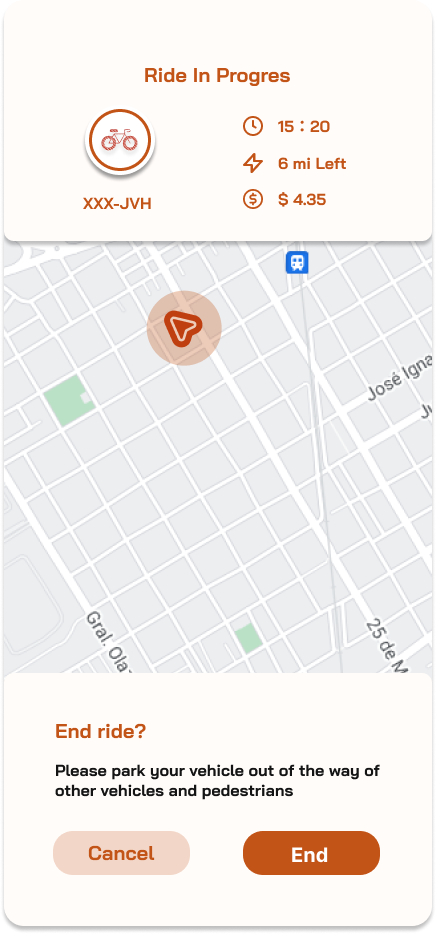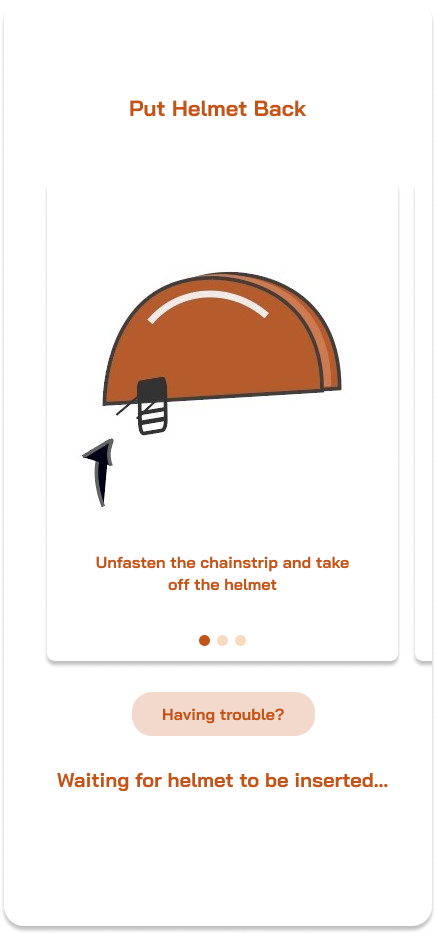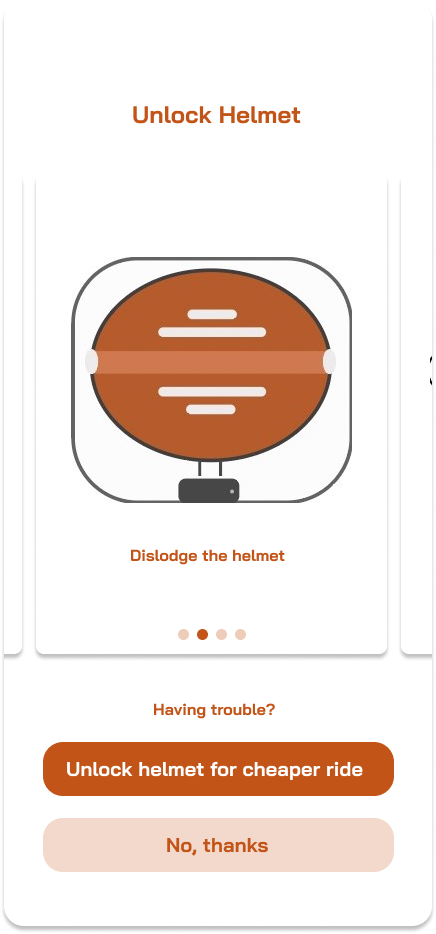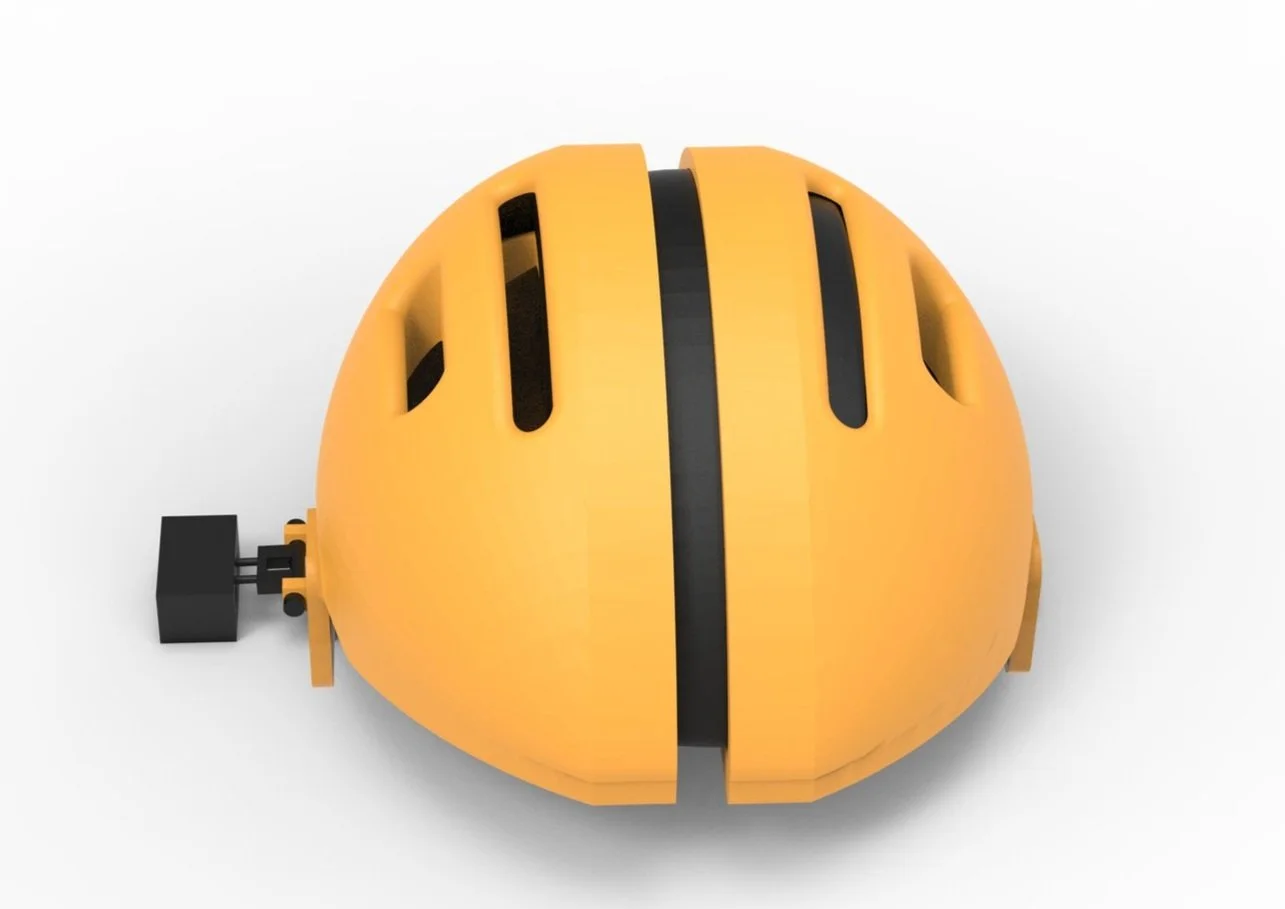
Pumpki
Helmet Design + User Interface for shared bikes
Group members: Xiyue Hu, Diya Wu, Yuqing Jin, Zonghua Zhou
Time Spent: 2 Months
Keywords: Protective / UXUI / Product Design / Design solution
A group design project to provide design solutions for the problem we identified from daily life.
What problem we were trying to solve:
Every year, shared bike/scooter companies pay heavy fines and law suites fees for riders who
encounter severe accidents from riding shared bikes/scooters without proper protection.
We are trying to solve the safety problem during shared bike/scooter riding by introducing an
attached helmet.
Design Processes
01 Identify
Identify the user problem
User interviews
02 Ideate
Finding possible solution
03 Decide
Decide our design direction
Low-fidelity prototype
04 Prototype
Prototype both product and interface
05 Test
User test and feedbacks
Future steps
01 Identify
Research:
The importance of wearing a helmet
Significant Quotes
‘Each year, about 2 percent of motor vehicle crash deaths are bicyclists. Although child bicyclist deaths have declined over the years, deaths among bicyclists aged 20 and older have tripled since 1975. In most bicyclist deaths, the most serious injuries are to the head, highlighting the importance of wearing a bicycle helmet.’ (IIHS Fatality Facts: Bicycles - 2019)
‘Those pushing for helmet requirements point to a 2019 study from the University of California, Los Angeles, which found that of the 249 scooter-related injuries in the study, 40% were head injuries, and less than 5% of those in the study had worn a helmet’
‘Almost three-quarters of fatal crashes (74%) involved a head injury. Nearly all bicyclists who died (97%) were not wearing a helmet.’ ( New York City https://www.helmets.org/stats.htm )
A recent study by The Journal of the American Medical Association (JAMA) Surgery discovered that in 2019 less than 5% of injured riders wore helmets.
Laws on helmets from states
DC: It shall be unlawful for any person under 16 years of age to operate or to be a passenger on a bicycle or any attachment to a bicycle on a public roadway. ( no restrictions on adults)
VA: Virginia The State has, and the County enforces, helmet requirements for bicycle riding by people 14 years of age or younger. E-scooters are not currently included in the State’s helmet requirement. The County encourages all riders of micro-mobility devices to wear a helmet.
Nationally: There is no federal law in the U.S. requiring bicycle helmets. The states and localities below began adopting laws in 1987. Most are limited to children under 18, but there are 49 all-ages laws broken out on our all-ages page.
All-Ages Helmet Laws for bicycle riders: https://www.helmets.org/allageshelmetlaws.htm
User Interview
The number of interviews: 10
Interview questions:
Name, age, job, gender, location
How often do you use shared bikes ( lime, bird, …)
What are the usual scenarios for you using shared bikes? (why shared bikes? No other choices.)
When did the last time you used shared bikes? Where were you and why?
Have you ever felt in danger riding a shared bike? If so, why
How often do you wear a helmet while you are using shared bikes?
(If it's not very often ) – what are the factors that stop you from wearing a helmet while riding shared bikes?
Will adding a folded/attached helmet increase your willingness to ride share bikes?
If there’s an attached helmet on the shared bike, what features/ functions do you wish it to have?
Light, small, strong(resistant), not easy to be stolen -- which feature do you think is most important to an attached helmet?
Have you recognized any uncomfortable situations using a bike app?
Do you think having the instruction of wearing a helmet could help you to remember?
02 Ideate
Most serious bike accidents result in head injury, and bicycle lanes and helmets may reduce the risk of death.
Most areas put restrictions on how under-age people should ride with helmets, but no rules on adults( but still highly encouraged)
If the government required everyone must wear a helmet, it didn’t decrease accidents. Instead, this cut potential use in half by limiting casual rides.
Almost all the interviewees said they never wear helmets during shared bike/scooter rides, and it felt a bit dangerous riding. When it comes to the desired feature for attached helmets, below are the most mentioned features:
Cleanness
Adjustable size
Lighting
Free of charge
Safety - no string attached to the bikes
Theft - proof
And those are some points to think about for app development:
The interface of the bike range: Most users think current e-bike apps don’t have a clear and intriguing way to show the range left for bikes, while it’s a piece of crucial information that needs to be considered before unlocking the bike.
The instruction style: 3 of 5 users complain about the instructions on current apps. The instructions are mostly presented in the text, with several steps that must be followed. Users said this instruction style is boring, inaccurate, hard to follow, and lacks images.
The feedback access: Users also mentioned that submitting feedback after finishing the ride is stiff. The access only appeared when they were having trouble locking the bike – instead of encouraging them to send critical suggestions.
03 Decide
Based on our research and interviews, we decided to make an adjustable helmet for people which has only one size but be able to fit every user. With that in mind, we also thought we need to design an app to show how to use the helmet and encourage shared bike users to wear it.
04 Prototype
Mobile App Prototype
Helmet Prototype
05 Test
Safety test: we put apples as a simulation of the actual user head. We ran several safety tests to see if the “user head” remained in good condition after hitting the ground heavily. -> Result: all “user heads” survived the hitting test.
Cleaning test: we run the cleaning test using different kinds of cleaning spray -> Result: avoid using cleaning spray that contains a high percentage of hydrogen peroxide as it might cause color changes on helmet materials.
Fitting test: we put apples of different shapes as a simulation of the actual user head and fit them with our helmets, and shook them. -> Result: Apples can stay in the helmet during the test. Because the adjustable feature is not fully functional, smaller ones could be thrown out from the helmet if we shake them hard.
App usability test: We asked five people to use our app prototype. -> Result: They think the app demonstrates how to use the helmet clearly, and would effectively encourage users to use helmets because of the cheaper ride idea.
Future Steps:
Scaling up
1. Testing on bigger markets: run safety and fitting tests on a more diverse population.
2. Calculate the overall budget for helmet materials and maintenance costs and adjust the
materials accordingly.
Selling/Distributing
1. Reach out to corporations with share bikes/scooter companies
2. Integrate helmets to actual bikes/scooters, integrate user interface with actual mobile applications
New features/advancement
1. Lighting feature during night rides
2. Using helmet surfaces as advertisement spaces
3. Easy-to-clean for helmet surface






























